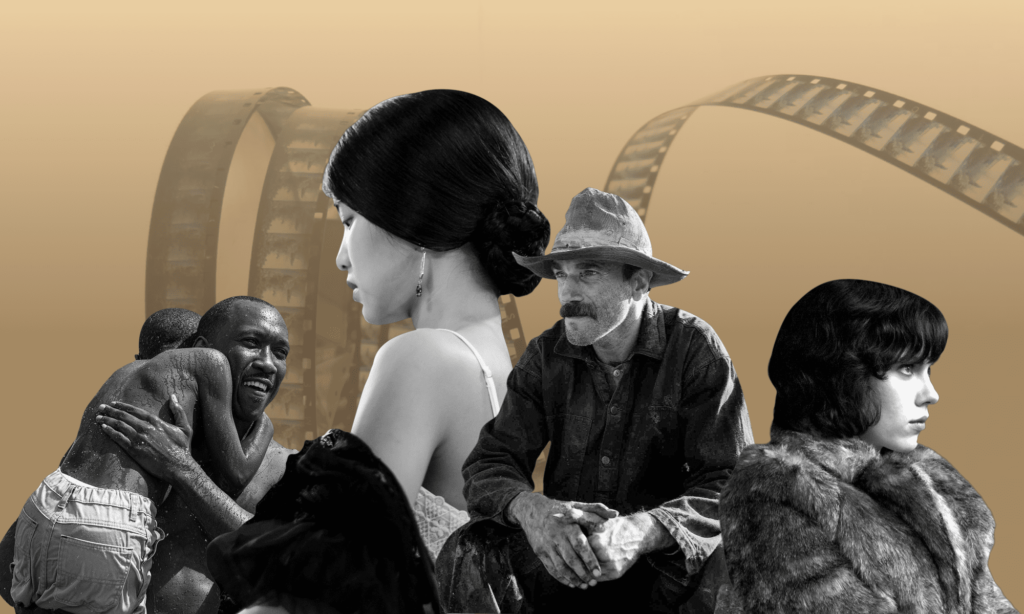The Making of Famous 21+ Films sets the stage for an exploration of mature cinema’s evolution, from its technical innovations to its societal impact. This journey delves into the creative choices shaped by censorship, the recurring themes that resonate with audiences, and the influence of iconic figures who defined the genre. We’ll examine the business strategies behind these productions, the role of technology, and the critical and audience responses that shaped their legacies.
From the groundbreaking cinematography of early mature films to the sophisticated special effects of contemporary productions, we will analyze how technological advancements and evolving societal norms have impacted the creation and reception of adult-oriented cinema. We’ll also consider the economic realities of producing and distributing films with mature content, and the marketing strategies employed to reach target audiences. The discussion will further investigate the critical acclaim, controversies, and lasting impact of these films on cinematic history.
The Evolution of Mature Filmmaking Techniques
The landscape of mature filmmaking, specifically films rated for audiences 21 and over, has undergone a dramatic transformation over the past half-century. Technological advancements, shifting societal norms, and evolving artistic sensibilities have all contributed to a fascinating evolution in cinematography, storytelling, and thematic exploration within this genre. This evolution is not merely a progression of technical capabilities, but also a reflection of broader cultural changes and the ongoing conversation about mature themes in cinema.
The progression of cinematography in 21+ films mirrors broader cinematic advancements, yet with its own unique trajectory. Early films, often relying on stark lighting and limited color palettes, aimed for a gritty realism, sometimes bordering on exploitation. Later, more sophisticated techniques emerged, influenced by advancements in camera technology and post-production effects.
Cinematography in 21+ Films: A 50-Year Overview
The 1970s saw a rise in gritty realism, often characterized by handheld camerawork and naturalistic lighting, exemplified by films like *Taxi Driver* and *The French Connection*. The use of grainy film stock and desaturated colors contributed to a sense of unease and moral ambiguity. In contrast, the 1980s and 90s witnessed a shift towards more stylized visuals, with films like *Basic Instinct* employing sharp lighting and vibrant colors to enhance the erotic and suspenseful aspects of their narratives. The late 1990s and early 2000s saw the rise of digital filmmaking, allowing for greater flexibility and control over visual effects, as seen in films like *Fight Club*. More recently, the use of high-dynamic range (HDR) imaging and advanced color grading techniques have resulted in visually stunning and emotionally resonant films.
Lighting and Color Palettes in Mature Films
Early 21+ films often employed high-contrast lighting, creating a stark division between light and shadow, reflecting the moral ambiguity and often violent nature of the narratives. Think of the stark, shadowy lighting in films noir of the 1940s, a style that influenced later mature films. In contrast, later decades saw a broader range of lighting techniques, from the soft, diffused lighting used to create intimate scenes in romantic dramas to the harsh, glaring lights employed in action thrillers. Color palettes also evolved. The muted, desaturated tones of earlier films gave way to more vibrant and expressive color schemes, reflecting a shift towards a more visually striking aesthetic. For instance, the use of deep reds and blues in psychological thrillers to heighten the sense of suspense and unease.
Evolution of Storytelling Techniques in Mature Films
The narrative structures and pacing of mature films have also undergone significant changes. Early films often relied on linear narratives with a clear beginning, middle, and end. However, later films increasingly experimented with non-linear storytelling, flashbacks, and multiple perspectives, reflecting a more complex and nuanced understanding of human psychology. The pacing of mature films also evolved. Earlier films often maintained a slower pace, allowing for character development and atmospheric tension. Later films, particularly action thrillers and crime dramas, embraced faster pacing and more frequent action sequences to maintain audience engagement. The shift towards more complex narrative structures mirrors the growing sophistication of storytelling techniques in cinema as a whole. Films like *Pulp Fiction* and *Memento* are prime examples of this experimentation with non-linear storytelling and fragmented narratives.
Impact of Censorship and Ratings Systems
The evolution of mature filmmaking is inextricably linked to the fluctuating landscape of censorship and ratings systems. These regulatory bodies, while intending to protect audiences, have profoundly impacted the creative choices of filmmakers, influencing both the content produced and its accessibility to viewers. The tension between artistic expression and societal norms has shaped the history of adult cinema, resulting in a complex interplay of defiance, adaptation, and compromise.
The influence of censorship boards on creative choices is multifaceted. Historically, censorship often resulted in self-censorship, with filmmakers anticipating potential objections and altering their scripts or visuals preemptively. This preemptive action could lead to a homogenization of themes and a reluctance to explore controversial subjects. Conversely, some filmmakers actively challenged censorship, using creative techniques to subtly convey their messages, thereby indirectly highlighting the limitations imposed by the system. The constant negotiation between artistic vision and censorship regulations has, in many ways, shaped the very nature of adult films.
The Effects of Different Ratings Systems
The introduction of ratings systems like the MPAA’s NC-17, R, and PG-13 in the United States, and similar systems internationally, provided a more nuanced approach to content regulation than outright censorship. However, these systems have still had a significant impact on the content and distribution of mature films. The NC-17 rating, in particular, has been considered a “box office poison,” as many theaters are reluctant to screen films with this rating, limiting their reach and profitability. The R rating, while allowing for a wider range of mature content, still necessitates careful consideration of what can be depicted. This has led to filmmakers making strategic decisions about the level of violence, sexuality, or language included in their films to avoid an NC-17 rating and ensure wider distribution. The existence of these ratings, therefore, acts as a form of implicit censorship, guiding creative choices even without direct intervention.
Films that Challenged Censorship
Several films have pushed the boundaries of censorship and ratings systems, directly confronting the limitations imposed upon artistic expression. For instance, Stanley Kubrick’s *A Clockwork Orange* (1971) initially faced considerable controversy for its graphic violence and disturbing themes. Its release and subsequent alterations demonstrate the power dynamics between filmmakers and censorship boards. Similarly, *Pink Flamingos* (1972) by John Waters, with its extreme transgressive content, actively challenged societal norms and became a cult classic in part due to its defiance of conventional censorship. These examples, and many others, highlight the ongoing struggle between artistic freedom and societal expectations, shaping the landscape of mature cinema. The films that successfully challenged these regulations often did so not through overt defiance, but by using creative strategies that allowed them to circumvent or subtly critique the existing systems.
The Role of Mature Themes in Film
Mature themes have always been a significant, albeit often controversial, element in cinema. Their inclusion pushes creative boundaries, forcing filmmakers to grapple with complex societal issues and human experiences, often resulting in powerful and thought-provoking works. The skillful handling of these themes can elevate a film beyond simple entertainment, prompting introspection and dialogue. Conversely, poorly executed mature content can lead to gratuitous exploitation and a trivialization of serious issues.
The exploration of mature themes in film has evolved considerably, reflecting societal shifts in attitudes and the development of cinematic language. Early examples often relied on suggestion and implication due to censorship restrictions. Modern filmmaking, however, benefits from greater freedom of expression, allowing for more direct and nuanced portrayals. This evolution, however, doesn’t negate the ongoing debate surrounding the responsible portrayal of such content.
Recurring Mature Themes in 21+ Films
Mature themes frequently explored in successful 21+ films can be broadly categorized into violence, sexuality, substance abuse, and psychological trauma. Violence, ranging from stylized action sequences to graphic depictions of brutality, serves diverse narrative purposes, from exploring the consequences of conflict to critiquing societal structures. Sexuality’s portrayal varies widely, from subtle romantic subtext to explicit depictions of intimacy, often used to explore power dynamics, identity, and emotional connection. Substance abuse narratives can serve as cautionary tales or delve into the complexities of addiction and its impact on individuals and relationships. Finally, psychological trauma, encompassing themes of abuse, loss, and mental illness, can offer profound insights into the human condition and its resilience.
Evolution of Mature Theme Portrayals
The depiction of mature themes has undergone a significant transformation across different eras and cultures. Early Hollywood cinema often relied on veiled allusions and symbolic representation due to strict censorship codes like the Hays Code. The sexual revolution and subsequent loosening of censorship in the latter half of the 20th century allowed for greater explicitness, though this was often met with controversy and resistance. Different cultures also exhibit varying levels of tolerance and acceptance of mature themes in film, influencing both the portrayal and reception of these themes. For instance, a film depicting violence might be viewed as a social commentary in one culture and glorified brutality in another.
Comparative Analysis of Mature Theme Handling
| Director | Film | Mature Theme Focus | Portrayal Style |
|---|---|---|---|
| Stanley Kubrick | A Clockwork Orange | Violence, Sexuality | Stylized, allegorical; explores the nature of free will and societal control through graphic depictions. |
| Martin Scorsese | Taxi Driver | Violence, Psychological Trauma | Gritty, realistic; portrays the descent into violence and alienation through a psychologically complex protagonist. |
| Ingmar Bergman | Scenes from a Marriage | Sexuality, Psychological Trauma | Intimate, emotionally raw; explores the complexities of a failing marriage and its psychological toll. |
| David Fincher | Seven | Violence, Psychological Trauma | Dark, suspenseful; uses graphic violence to illustrate the consequences of unchecked rage and moral decay. |
The Influence of Iconic Directors and Actors

The landscape of 21+ cinema has been profoundly shaped by the bold visions of certain directors and the compelling performances of iconic actors. Their contributions extend beyond individual films; they have established conventions, challenged boundaries, and redefined what is considered acceptable and even expected in mature filmmaking. This section will explore the impact of these key figures, examining how their individual styles and choices have influenced the genre as a whole.
The interplay between directorial vision and actorial performance is crucial in mature films, where nuanced portrayals of complex characters and emotionally charged situations are paramount. A director’s ability to guide actors, to elicit the necessary vulnerability and intensity, is vital in bringing these stories to life. Conversely, a powerful actor’s interpretation can elevate even a well-written script to a new level of impact.
Contributions of Influential Directors
Several directors have significantly shaped the aesthetic and thematic concerns of 21+ cinema. Their distinct styles, whether through innovative camera techniques, provocative subject matter, or a willingness to push boundaries, have left an enduring mark. For instance, Ingmar Bergman’s exploration of psychological torment and existential themes in films like *The Seventh Seal* and *Wild Strawberries* established a benchmark for the exploration of complex emotional landscapes in mature cinema. Similarly, Stanley Kubrick’s mastery of visual storytelling and his willingness to tackle taboo subjects, as seen in *A Clockwork Orange* and *Eyes Wide Shut*, continues to inspire filmmakers today. The raw, unflinching realism of directors like Martin Scorsese, evident in films like *Taxi Driver* and *Goodfellas*, redefined the depiction of violence and urban decay in mature narratives.
Impact of Iconic Actors on Mature Character Portrayals
Iconic actors have played a crucial role in shaping the perception and acceptance of mature themes in film. Their performances often transcend mere acting; they become synonymous with the characters they embody, leaving a lasting impact on audiences. Marlon Brando’s raw intensity in films like *A Streetcar Named Desire* and *On the Waterfront* redefined masculinity on screen, while Meryl Streep’s ability to portray complex, multifaceted female characters in films such as *Sophie’s Choice* and *The Bridges of Madison County* has consistently challenged and expanded the portrayal of women in mature cinema. The range and depth of performance from actors like Robert De Niro, Al Pacino, and Jack Nicholson have consistently elevated the storytelling in films dealing with challenging subject matter.
Timeline of Significant Figures in Mature Filmmaking
A chronological overview helps illustrate the evolution of mature filmmaking and the contributions of key individuals.
| Year | Director/Actor | Film(s) | Significance |
|---|---|---|---|
| 1951 | Marlon Brando | A Streetcar Named Desire | Groundbreaking portrayal of raw masculinity and emotional vulnerability. |
| 1957 | Ingmar Bergman | The Seventh Seal | Established a new standard for exploring existential themes and psychological depth. |
| 1976 | Martin Scorsese | Taxi Driver | Raw depiction of urban alienation and violence. |
| 1980 | Robert De Niro | Raging Bull | Powerful performance showcasing self-destruction and the complexities of human nature. |
| 1999 | Meryl Streep | One True Thing | Complex portrayal of a mother-daughter relationship dealing with difficult truths. |
The Business of Mature Films

The financial landscape of R-rated and NC-17 films is a complex ecosystem influenced by production costs, marketing strategies, distribution channels, and ultimately, box office performance. Unlike family-friendly films, the target audience for mature content is inherently smaller, necessitating more focused and often riskier financial strategies. Understanding these intricacies is crucial to comprehending the success and failures of films intended for adult viewers.
The production of a mature film, while potentially benefiting from lower production costs in certain areas (e.g., avoiding the need for extensive CGI or family-friendly sets), often requires careful budgeting due to the higher potential for controversy and potentially limited distribution avenues. Marketing expenses can also be substantial, demanding creative strategies to reach a specific demographic without alienating or misrepresenting the film’s content. Distribution deals, particularly for independent productions, can be challenging to secure, adding another layer of financial complexity.
Production Costs and Budgeting, The Making of Famous 21+ Films
Budgeting for a mature film requires a keen understanding of the target audience and the potential return on investment. Unlike family films, which often have broader appeal and higher potential box office revenue, R-rated films frequently rely on strong critical acclaim, a dedicated fanbase, or a unique selling proposition to generate profit. For instance, a low-budget horror film aiming for a niche audience might have a smaller production budget than a large-scale action thriller, even if both are R-rated. Effective cost control is paramount, focusing on efficient resource allocation without compromising artistic vision.
Marketing Strategies for Mature Content
Marketing mature films necessitates a nuanced approach. Directly targeting the desired demographic is crucial, and this often involves using platforms and channels that cater to adult audiences. Social media campaigns, for example, might focus on specific online communities or use targeted advertising to reach individuals interested in the film’s genre or themes. The marketing materials themselves need to be carefully crafted to accurately represent the film’s content without being overly explicit or misleading. A trailer, for instance, needs to showcase the film’s tone and style without revealing crucial plot points or exceeding the boundaries of acceptable marketing practices. Furthermore, collaborations with relevant influencers or critics can significantly impact the film’s visibility and appeal.
Box Office Performance Across Genres
The box office success of 21+ films varies significantly across genres. While some genres, such as horror, consistently deliver profitable R-rated releases, others, like romantic dramas, might find it harder to achieve widespread commercial success within the mature film market. The success of a specific film is also contingent on numerous factors including critical reception, audience word-of-mouth, and effective marketing. For instance, a critically acclaimed horror film like *The Conjuring* (2013) significantly outperformed many other R-rated releases in its year, demonstrating the potential for substantial box office returns within the genre. Conversely, R-rated romantic dramas often face a steeper uphill battle, needing to rely heavily on strong critical praise and dedicated fanbases to achieve comparable box office success.
Technological Advancements and Their Impact: The Making Of Famous 21+ Films
The evolution of filmmaking technology has profoundly impacted the creation and reception of films with mature themes. From the earliest days of cinema, technological limitations shaped narrative choices and the way adult content was portrayed. The advancements of the last few decades, however, have allowed filmmakers to explore mature themes with unprecedented levels of realism, intimacy, and visual impact. This has led to both creative breakthroughs and ethical considerations, fundamentally changing the landscape of adult cinema.
Technological advancements have enabled filmmakers to depict mature themes with a significantly heightened level of impact. Special effects, for instance, can create visceral and immersive experiences, allowing audiences to connect with the emotional core of mature narratives on a deeper level. Digital filmmaking has also broadened the creative possibilities, offering greater control over lighting, color grading, and visual effects, which can be used to emphasize the emotional weight of scenes dealing with complex and sensitive subject matter. The ability to manipulate imagery digitally allows for a level of nuance and control previously unimaginable.
Special Effects and the Depiction of Violence and Sexuality
The development of sophisticated special effects has significantly altered the depiction of violence and sexuality in mature films. Early depictions often relied on suggestion and implication, constrained by the limitations of practical effects. Modern technology, however, allows for hyperrealistic portrayals of violence, creating a visceral impact that can be both compelling and unsettling. Similarly, the digital manipulation of imagery allows for a more nuanced and controlled depiction of sexuality, enabling filmmakers to explore complex themes with greater precision and subtlety. The film “Se7en” (1995), for example, used practical and CGI effects to depict graphic violence in a way that heightened the film’s disturbing atmosphere and thematic resonance. Conversely, films like “Blue Valentine” (2010) utilized intimate close-ups and carefully crafted lighting to convey the emotional rawness of a deteriorating relationship, achieving impact through subtle visual cues rather than explicit imagery.
Digital Filmmaking and the Exploration of Psychological Themes
Digital filmmaking techniques have facilitated the exploration of psychological themes in mature films. The ability to precisely control lighting, color palettes, and camera angles allows filmmakers to create a specific mood and atmosphere, perfectly mirroring the internal states of characters grappling with complex psychological issues. For instance, the use of desaturated colors and stark lighting in films like “Black Swan” (2010) effectively conveyed the protagonist’s descent into madness, amplifying the psychological tension and the film’s disturbing thematic elements. The precision offered by digital post-production allows for fine-tuning of these visual elements, resulting in a more controlled and effective expression of psychological turmoil. The flexibility and cost-effectiveness of digital filmmaking also enables independent filmmakers to explore mature themes with greater freedom and creative control, often resulting in more innovative and experimental approaches to storytelling.
High-Definition and the Increased Realism of Mature Content
The advent of high-definition (HD) and ultra-high-definition (UHD) filmmaking has dramatically increased the realism of mature content. The sharper image quality allows for a more intimate and detailed portrayal of characters and their emotional states, heightening the impact of scenes dealing with sensitive themes. This heightened realism can be both a powerful tool for filmmakers and a potential source of ethical debate, as it can blur the line between fiction and reality, demanding greater sensitivity in the portrayal of mature content. Films like “Manchester by the Sea” (2016), with its naturalistic style and intimate framing, effectively utilized high-definition to convey the raw emotional pain of the protagonist, creating a deeply affecting viewing experience. The increased realism, however, necessitates careful consideration of the ethical implications of portraying potentially disturbing or triggering content with such high fidelity.
Critical Reception and Audience Response
The critical and audience reception of 21+ films is a complex interplay of artistic merit, cultural context, and individual sensibilities. While critical acclaim often signifies a film’s artistic achievement, audience response is multifaceted, influenced by factors ranging from personal preferences to societal norms. The commercial success of these films is often a direct result of this dynamic interaction.
The relationship between critical reception and box office performance is not always straightforward. While positive reviews can drive audience interest and boost ticket sales, negative reviews can significantly hinder a film’s commercial prospects. However, a film’s marketing campaign, its genre, and the pre-existing popularity of its cast can all influence the impact of critical reviews on its commercial success. Controversial films, for instance, may attract large audiences precisely because of the negative press they generate.
Critical Acclaim and Controversies Surrounding Notable 21+ Films
Many films rated for mature audiences have garnered significant critical praise, earning accolades at prestigious film festivals and winning numerous awards. Examples include *Pulp Fiction* (1994), which revolutionized independent filmmaking and earned multiple Academy Awards, and *Taxi Driver* (1976), a gritty crime drama lauded for its cinematography and powerful performances. Conversely, films like *The Last Temptation of Christ* (1988) and *Natural Born Killers* (1994) sparked intense controversies, facing accusations of blasphemy and glorifying violence, respectively, despite receiving critical attention for their ambitious storytelling and technical prowess. These controversies, though negatively impacting some aspects of their reception, often fueled public discourse and increased their notoriety.
Audience Reactions to Mature Films Across Different Demographics
Audience reactions to mature films vary significantly across different demographics. For example, younger audiences may be more sensitive to explicit content than older viewers, while different cultural backgrounds can shape perceptions of themes like violence, sexuality, and profanity. A film that resonates deeply with one demographic might be met with indifference or even disapproval by another. The marketing and distribution strategies employed by studios also play a crucial role in shaping audience expectations and determining the film’s ultimate reception. The marketing materials for a film like *The Godfather* (1972) were tailored to appeal to adult audiences, influencing its reception and ensuring it found a significant audience within that demographic.
Impact of Critical Reviews on the Commercial Success of 21+ Films
The impact of critical reviews on the commercial success of 21+ films is not always predictable. Positive reviews from influential critics can create a “buzz” around a film, attracting wider audiences and generating strong box office results. However, negative reviews can damage a film’s reputation and discourage potential viewers, potentially leading to lower ticket sales. The weight given to critical reviews varies depending on the film’s genre, target audience, and marketing strategy. A critically acclaimed art-house film might not achieve the same box office numbers as a blockbuster action film, even with favorable reviews. Conversely, a poorly reviewed action film might still succeed commercially if it appeals to a broad audience through its action sequences and special effects.
Genre Conventions in Mature Films
Mature films, by their very nature, often explore complex themes and darker aspects of human experience. Genre conventions, while providing a familiar framework, are frequently subverted or reinterpreted within these films to enhance the impact of their mature narratives. The use of established tropes can create audience expectations that are then deliberately challenged, leading to a more nuanced and engaging viewing experience.
Genre conventions in mature films serve a dual purpose: they provide a readily accessible structure for the audience to grasp the narrative, while simultaneously allowing filmmakers to explore the complexities of their chosen themes in a more meaningful way. By understanding the established conventions of a genre, viewers can better appreciate how filmmakers utilize, modify, or completely dismantle them to achieve specific artistic and thematic goals.
Crime Thriller Conventions in Mature Films
Crime thrillers often rely on suspense, morally ambiguous characters, and intricate plots involving criminal activity. Mature films within this genre frequently amplify the darkness inherent in these conventions. For example, the protagonist might not be a clear-cut hero, possessing flaws and engaging in morally questionable actions to achieve their goals. The suspense is often heightened through graphic violence or depictions of psychological trauma, pushing the boundaries of what is typically shown in mainstream thrillers. Films like *Seven* (1995) exemplify this, utilizing graphic violence and disturbing imagery to explore themes of morality and justice. In contrast, *Prisoners* (2013) uses suspense and ambiguity to explore the lengths to which desperate parents will go to protect their children, challenging the conventional good versus evil dynamic.
Psychological Drama Conventions in Mature Films
Psychological dramas often delve into the inner turmoil and mental states of their characters. Mature films in this genre often employ unreliable narrators, fragmented timelines, and surreal imagery to reflect the fractured psyches of their protagonists. The exploration of mental illness, trauma, and complex relationships are central to many of these films. *Black Swan* (2010), for example, uses dreamlike sequences and unsettling imagery to depict the psychological disintegration of a ballerina. *The Silence of the Lambs* (1991), on the other hand, uses the interplay between a brilliant but disturbed psychiatrist and a cunning serial killer to explore themes of power, manipulation, and the nature of evil, subverting typical conventions of the thriller genre by focusing deeply on the psychological profiles of the characters.
Subversion of Genre Conventions
Many mature films actively challenge and subvert established genre conventions. This subversion often serves to enhance the film’s thematic depth and create a more unsettling or thought-provoking experience. For instance, a romantic comedy might incorporate elements of dark humor and cynicism, contrasting sharply with the typically upbeat tone of the genre. Similarly, a horror film might focus more on psychological dread than on jump scares, forcing the audience to confront their own fears and anxieties. *Fight Club* (1999), a film that blends elements of crime thriller and dark comedy, subverts audience expectations by presenting a seemingly conventional narrative that ultimately deconstructs itself. The film’s unreliable narrator and shocking twists challenge the typical conventions of both genres.
The Future of Mature Filmmaking
The landscape of mature filmmaking is poised for significant transformation, driven by technological advancements, evolving audience preferences, and the ever-shifting power dynamics within the entertainment industry. The lines between traditional cinema and streaming platforms are blurring, presenting both challenges and unprecedented opportunities for creators and consumers alike. The future of 21+ films will likely be characterized by increased diversity, bolder storytelling, and a more nuanced exploration of complex adult themes.
The increasing dominance of streaming services is fundamentally reshaping how mature films are produced, distributed, and consumed. This shift empowers independent filmmakers and allows for a wider range of voices and perspectives to be heard, potentially leading to a more diverse and representative portrayal of adult experiences. However, it also presents challenges related to content moderation, algorithm-driven recommendations, and the potential for a fragmented viewing audience. The success of platforms like Netflix and HBO Max in commissioning and distributing original mature content demonstrates the viability of this model, while also highlighting the ongoing struggle to balance creative freedom with platform-specific guidelines and audience expectations.
Streaming Services and Audience Preferences
Streaming platforms have significantly altered the consumption patterns of mature films. The on-demand nature of these services allows for greater accessibility and personalized viewing experiences, catering to niche audiences and specialized tastes. This increased accessibility can lead to a broader exploration of complex themes and narratives previously considered too niche for theatrical releases. For instance, the success of limited-series dramas like “Succession” and “The White Lotus” on HBO Max showcases the growing appetite for intricate, character-driven narratives within a mature context, which previously might have struggled to find a large enough audience in traditional cinemas. However, the algorithm-driven nature of these platforms can also create echo chambers, potentially limiting exposure to diverse perspectives and potentially reinforcing existing biases.
Potential Themes and Storylines
The future of mature films will likely witness an expansion into previously unexplored thematic territories. The rise of social awareness and a greater emphasis on inclusivity will lead to more nuanced portrayals of marginalized communities and their experiences. We can expect a surge in films that tackle complex social and political issues with greater honesty and depth, reflecting the evolving conversations taking place in society.
Several potential themes and storylines for future 21+ films include:
- The exploration of the psychological impact of long-term societal trauma and its generational transmission.
- In-depth portrayals of complex family dynamics within diverse cultural contexts.
- Stories that challenge traditional gender roles and explore non-binary identities with sensitivity and nuance.
- Films that delve into the ethical implications of advanced technologies and their impact on human relationships.
- Mature explorations of climate change and its devastating consequences on human lives and societies.
These examples represent a move beyond simplistic narratives toward a more profound and nuanced understanding of the human condition, reflecting the increasing sophistication and maturity of contemporary audiences. The emphasis will likely shift from shock value to insightful storytelling, engaging viewers intellectually and emotionally.
Closing Notes
In conclusion, the journey into the making of famous 21+ films reveals a complex interplay of artistic vision, technological innovation, societal pressures, and commercial considerations. The evolution of mature filmmaking reflects not only changes in cinematic techniques but also broader shifts in cultural attitudes and technological capabilities. The enduring power of these films lies in their ability to explore challenging themes, push creative boundaries, and leave a lasting impact on audiences and the cinematic landscape.





